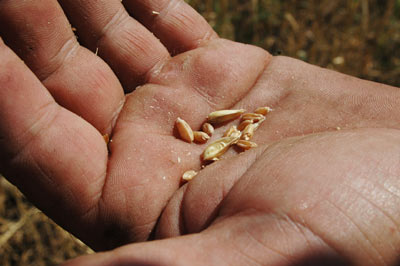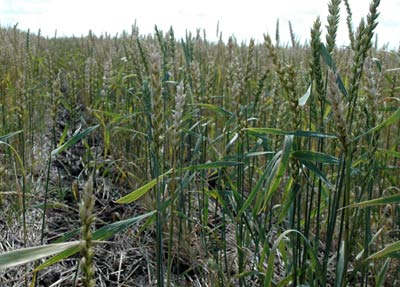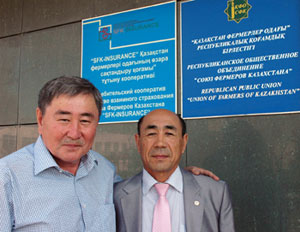Kazakhstan’s 2012 drought and high temperatures cut the country’s wheat harvests by more than half from 2011 output, but wheat under zero-tillage practices gave up to three times more grain than conventionally cultivated crops. Two million hectares are currently under zero tillage, making Kazakhstan one of the top-ten countries for conservation agriculture and helping to avoid severe wheat shortages.
“If no-till practices had not been used this period of drought, we would have gotten nothing. It would have been an absolute catastrophe,” says Valentin Dvurechenskii, Director General of the Kostanay Agricultural Research Institute in Kazakhstan, giving his verdict on the 2012 wheat crop.
After farmers planted their wheat in April, Kostanay—the country’s main wheat growing region—went two months without rain. Making matters worse, daily temperatures were several degrees above normal. At the time, farmer and Director General of the Agrofirm Dievskaya, Oleg Danilenko, echoed the view of peers: “I’ve been a farmer for 35 years, and I’ve never seen anything like this.” Danilenko said the harsh conditions pointed up the advantages of conservation agriculture, which involves reduced or zero tillage, keeping crop residues on the soil, and rotating crops. “No other results have been nearly as successful.”

Lack of rain darkens crop outlook
In the village of Tonkeris, 45 km from the capital Astana in the Akmola region, farmers’ fields had received no rainfall between May and September. According to farmers in the area, drought conditions used to be rare but are becoming more frequent. “I’ve been a farmer for 30 years,” said Idris Kozhabayev. “There was drought like this in 2000 and 2010. In recent years, it’s getting worse.”
Cultivated using conventional practices, the fields of Akmola were expected to produce only enough wheat for next year’s seed. “The farmers’ fields I work with all look like this. Some are worse,” said Daniyar Andibayev, an agronomist in the region.
Meanwhile, in Kostanay, many farmers had adopted conservation agriculture techniques that protected them from drought’s worst effects. With these, farmers reported yields of 2 tons per hectare, while some farmers using conventional practices lost their entire crop.

Conserving where it counts
Kazakhstan is the world’s sixth largest wheat exporter. More than 14 million of the country’s 15 million hectares of wheat is rainfed, meaning the crop relies on precipitation and is thus vulnerable to dry weather. Reports in January 2013 said the 2012 drought had shrunk the wheat crop 57% from 2011’s record harvests.
Farmers are initially attracted to zero tillage and conservation agriculture because the approaches dramatically cut costs: farming this way requires less labor, machinery use, fuel, water, or fertilizers. In rainfed cropping, conservation agriculture can also boost yields.
Research has shown that conservation agriculture increases soil moisture by as much as 24% on most fields. In Kazakhstan the practices capture snow on the surface and improve water retention under heavy snowfall and subzero temperatures. Zero tillage also augments soil organic matter and cuts erosion by 75-100%. All this has helped to nearly double average wheat yields, from 1.4 to 2.6 tons per hectare, according to Dvurechenskii. In December 2011 Dvurechenskii was awarded the “Gold Star” medal and the rank “Hero of Labor of Kazakhstan” by the country’s President, in recognition of his work to promote conservation agriculture.
The findings of a 2012 FAO-Investment Centre mission to Kazakhstan1 suggest that adoption of zero tillage and conservation agriculture had raised domestic wheat production by almost 2 million tons. According to the mission report, this represents some US$ 0.58 billion more income over 2010-12, enough grain to satisfy the annual cereal requirements of almost 5 million people, and the sequestering of about 1.8 million additional tons of CO2 per year.
Pushing out with better practices
With the support of CIMMYT, FAO, ICARDA, the World Bank, the Ministry of Agriculture of Kazakhstan, and other international organizations and donors, Kazakhstan went from practically nothing under conservation agriculture in 2000 to 0.5 million hectares in 2007. In 2012, as a result of ongoing farmer engagement through demonstration plots, field days, and close work with farmer unions, conservation agriculture is now practiced on 2.0 million hectares—13% of the country’s wheat-growing area.”This amazing adoption is thanks to a few scientists who saw the potential, but more importantly to the pioneer farmers who perfected the techniques and put them into practice; farmers believe farmers,” says conservation agriculture expert Pat Wall, who, together with CIMMYT colleagues Alexei Morgounov and Muratbek Karabayev, initiated field trials with Kazakhstani scientists in the country’s northern steppes in 2000.
“The main achievement of CIMMYT in Kazakhstan has been the changing of the minds of farmers and scientists,” observes Bayan Alimgazinova, head of the Crop Production Department of KazAgroInnovation, a specialized organization created by the Ministry of Agriculture to increase the competitiveness of the country’s agricultural sector. Based on the positive results of research trials and tests in farmers’ fields, Kazakhstan’s current state policy calls for every province to pursue zero tillage.
“Kazakhstan has a wheat growing area of 15 million hectares presently and can increase it up to 20 million hectares,” added Murat Karabayev, CIMMYT representative in Kazakhstan. “This is extremely important for the food security of the country, the Central Asian region, and globally. There is a real opportunity to double yields using new advanced technologies and improved varieties. We’ve already seen this through conservation agriculture.”
For more information: Muratbek Karabayev, CIMMYT Representative in Kazakhstan (m.karabayev@cgiar.org)
CIMMYT’s conservation agriculture activities in Kazakhstan have been funded by the different sources, including from CIMMYT’s own resources and the comprehensive World Bank Agriculture Competitiveness Project (ACP). CIMMYT received two grants between 2008 and 2010 from the World Bank’s ACP to promote conservation agriculture practices in Kazakhstan.
 Interview: Auyezkhan K. Darinov, 2012Auyezkhan K. Darinov has been a farmer since 1993, and represents two million of his fellows as President-Chairman of the”Kazakhstan Farmers Union”. He works to unite and provide a voice to small and medium-scale farmers in Kazakhstan and to promote pro-farmer policies with the Ministry of Agriculture. What are the main activities of the Kazakhstan Farmers Union? What strategies do you use to introduce conservation agriculture to farmers? What does this year’s drought mean for farmers? Do you think more farmers will be convinced to start using conservation agriculture following the drought? What role has CIMMYT played in Kazakhstan? What are some of the main challenges you see for agriculture in Kazakhstan in the future? Wheat seems to have a special importance to farmers here. Why is that? 1 Unpublished; see also a 2009 Investment Centre report on zero tillage in Kasakhstan. |
 Climate adaptation and mitigation
Climate adaptation and mitigation